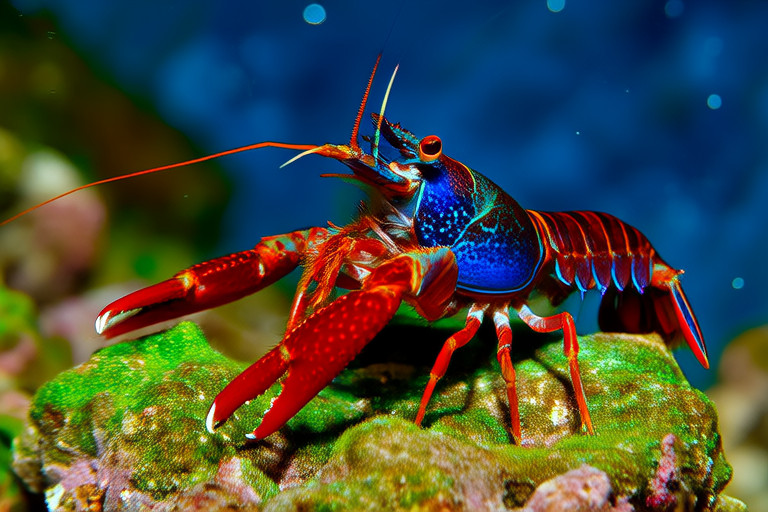
Keeping Coral Shrimp as Pets: A Beginner’s Guide
Introduction:
Coral shrimp, with their vibrant colors and graceful movements, have become a favorite among aquarium enthusiasts. Their striking appearance, which includes shades of red, blue, and white, makes them an attractive addition to any marine or reef aquarium. These small crustaceans are not only visually appealing but also play an important role in maintaining the health of your tank by cleaning algae and detritus. As the hobby of keeping marine life at home continues to grow, coral shrimp have gained significant popularity due to their relatively easy care requirements and beneficial presence in a reef environment.
Ideal Tank Setup:
Creating a suitable habitat for coral shrimp requires careful consideration of several factors, including tank size, substrate type, and hiding spots. For most species of coral shrimp, a minimum tank size of 20 gallons is recommended. This ensures there is enough space for them to move around comfortably without overcrowding. The substrate should be fine-grained sand that mimics their natural environment, allowing them to burrow when necessary. Additionally, incorporating live rock into the setup provides both shelter and a surface for beneficial bacteria growth. Live rock also serves as a source of food for coral shrimp through biofilm and algae.
Water Parameters:
Maintaining stable water conditions is crucial for the well-being of coral shrimp. They thrive in saltwater with specific parameters: salinity between 1.023 and 1.025 specific gravity, pH levels ranging from 8.1 to 8.4, and temperatures between 72°F and 78°F (22°C to 26°C). Regular testing using reliable test kits will help monitor these values. It’s important to note that sudden changes in water chemistry can stress these delicate creatures, so gradual adjustments are advisable.
Filtration Needs:
Efficient filtration systems are essential for maintaining clean water and ensuring the longevity of coral shrimp. Protein skimmers are particularly useful in removing dissolved organic compounds before they break down into harmful substances. Mechanical filters with sponge media capture larger particles while allowing beneficial microorganisms to pass through. Chemical filtration, such as activated carbon, helps eliminate toxins and odors. Combining different types of filtration methods creates a balanced system that supports optimal water quality.
Diet Requirements:
Coral shrimp are omnivores, meaning they eat both plant matter and animal-based foods. In nature, they feed on algae, detritus, and small organisms like plankton. To replicate this diet in captivity, offer a varied selection of food items. Algae wafers, spirulina flakes, and dried seaweed provide necessary nutrients. Supplementing their diet with frozen or freeze-dried foods such as brine shrimp, bloodworms, and mysis shrimp ensures they receive adequate protein. Feeding once or twice daily in small quantities prevents overfeeding, which could lead to poor water quality.
Suitable Tank Mates:
Choosing compatible tank mates for coral shrimp is vital to ensure peaceful coexistence within the aquarium. Generally, peaceful fish species that do not exhibit aggressive behavior towards small invertebrates make good companions. Some examples include dwarf gouramis, clownfish, and cardinal tetras. Avoid introducing larger predatory fish or those known for nipping fins or antennae. Compatible invertebrates like hermit crabs and snails can also be kept alongside coral shrimp provided there is sufficient space and hiding areas available.
Tips for Acclimatization:
Introducing new coral shrimp to your aquarium requires patience and proper acclimation techniques. Begin by floating the sealed bag containing the shrimp in the aquarium water for about 15 minutes to equalize temperature differences. Afterward, slowly add small amounts of aquarium water into the bag over the course of another 15 minutes. Once the shrimp appear active and ready, gently net them out of the bag and release them into their new home. Providing ample hiding places during this initial period helps reduce stress and allows them to adjust more easily.
Maintaining Health:
To keep coral shrimp healthy, regular maintenance practices must be followed diligently. Perform weekly partial water changes of approximately 10-15% volume to remove accumulated waste products. Clean equipment such as filters and decorations periodically to prevent bacterial buildup. Observing behavioral patterns and physical appearance regularly enables early detection of potential issues. If signs of illness are noticed, consult resources or seek advice from experienced aquarists promptly.
Common Challenges and Solutions:
Beginners often encounter certain difficulties when keeping coral shrimp. One common issue is finding suitable hiding spots; inadequate coverage may cause undue stress leading to reduced activity levels. Address this by adding more live rock structures or artificial caves designed specifically for invertebrates. Another challenge relates to dietary preferences where some individuals might show preference for specific types of food over others. Offering diverse options increases chances of acceptance. Lastly, maintaining appropriate water parameters poses a significant hurdle for novice aquarists. Investing in reliable testing kits and adhering strictly to recommended guidelines helps achieve consistent results.
In conclusion, keeping coral shrimp as pets offers numerous benefits for aquarium hobbyists. Their beautiful appearance combined with functional roles in maintaining tank cleanliness makes them valuable additions to any marine ecosystem. By understanding their specific needs regarding tank setup, water conditions, feeding habits, and social interactions, one can create a thriving environment conducive to long-term success. With dedication and continuous learning, even beginners can enjoy rewarding experiences caring for these fascinating creatures.






